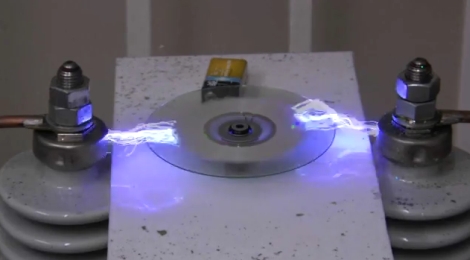
Here at Hackaday, we’re not against showing videos of gratuitous destruction just for the sake of it, though we try not to make it a habit. In this case we just couldn’t help ourselves. However, this video technically constitutes a security hack, as it does involve erasing sensitive information from CDs…
This may be the coolest CD eraser we’ve seen yet. Positioned between two high-voltage transformers, the spinning CD has its data violently stripped off in just a matter of seconds. To be fair, the data isn’t erased per se, but the metallic substrate on which the data is recorded is flaked off by the aggressive application of electricity.
Having destroyed our fair share of AOL CDs in the microwave over the years, we are now a bit sad over the fact that they were disposed of in such a lackluster fashion – if only we had one of these around!
Since we’re on the topic of mindless destruction, you might as well take a few minutes and check out this thermite-roasted Thanksgiving turkey, this self-destructing hard drive, or perhaps this thermic lance built from spaghetti.
You know, for science.
[youtube=http://www.youtube.com/watch?v=Zi_bMYFmFGg&w=470]















In the name of science!
That made my day
If you really want some AOL cds.. I still have a pile of them in a back closet.
Be nice to have a cage around the cd to catch the flying metal. Stuff is like glitter, it never cleans up.
Maybe I’m just paranoid, but I’d be using air to spin the cd instead of a spindle motor and 9v battery.
And there you have it… you can’t please everyone all of the time.
Something like this that is made of Awexometonium, and people still complain.
I say, TFC! Too F#$%^ng Cool!
o.O
That is all.
HMFS (Holy Motherf**king S**t) that was awsome! This is how Tesla would have destroyed CDs!
Well high voltage is cool, but what about using massage head of shover or some similary strong fluid or gas stream?
http://www.youtube.com/watch?v=eBxeVaDqe4g
(+ making recycled circuitboards as a bonus)
Now I know what to do with that 50kv, 5ma power supply I have…
Beautifully electrifing !
oh god the foil flakes coming off that would be the worst thing ever to clean.
so worth it though :D
so, if I were to take one of those discs, and spray the top side in chrome paint, would I then be able to use it again?
…how to make?
also, i would think a nice plastic case would be a good idea.
That is not two transformers as it says in the post, it is a single transformer (unless you have a description not shown on the youtube page).
and freaking cool, but I t\still love my Thermite
When I BETA Tested Windows Vista, supposedly a release candidate, I took it outside after an hour and burned the CD with over a pound of thermite (only 1/8 pound needed) and made sure all ten product keys were gone with it.
-Jimmy
Awesome…
But the data is in the plastic part and the metal is just reflective, right?
Okay – I might be missing something here but I thought on RW disks that the data were actually stored in a dye layer. I’m not saying that this would be easy to recover from and nearly impossible for 100% recovery – but if the foil layer were zapped off, would re-plating it (a feat in itself) allow for potential recovery?
This is still one of the coolest things I’ve seen in a while :)
I enjoyed that video immensely.
A bunch of people on youtube are arguing about if it would truly erase the data. The data on a mass produced, pressed CD may not be truly erased, but on a burned CD the dye layer would come off with the reflective layer. Why would you want to erase a mass produced CD anyway?
I wonder if the old sharpie fix would work for an entire CD.
How can you lose? Play with electricity AND volatile inhalants!
@Harvie.CZ how do you say roto-rooter in czech, to clear that stuff out of the drain ?
Seriously though, there were some reports of using the CD/DVD reflective layer as a conductive layer for circuitry. A polycarbonate layer needs to be dissolved first.
Would be neat to try and mask/etch patterns onto this reflective layer and then proceed with circuitry.
Breathing microscopic aluminum-metal particles is not very good for health. I would use a mask..
Other than that, AWWESOME!
MrX, if you saw what copious amounts of Mercury, Phosphor and other fun stuff that PhotonicIntuction breathes, this is Nothing !
Wow he is serious about destroying his kiddie pr0n ;) Dangerous and dumb. Just nuke it in the microwave for 12 seconds. The old standard.
@ Harvie Excellent! I love it! I recently used on to make a backlight reflector for LEDs for an old synth screen. Easy to etch and worked like a charm! Also, the cat loves to chase them down the hall if I roll them :)
I don’t see any instructions how to make it on Hack, or any other site? I love it!
Now play the movie backwards! It will look like the coolest cd creator ever!
Isn’t it possible to create a new mirror-layer (maybe with silvernitrat) on the CD to be able to read the data again?
“but the metallic substrate on which the data is recorded is flaked off by the aggressive application of electricity.”
Commercial discs at least, the data pits are impressed in the polycarbonate plastic, and the metal is just a reflector. In theory you could resurrect a disc damaged in this way by somehow re applying a shiny layer.
In practice you can’t recover such disks. “Metal layer has not been cleanly unmounted”. Those sparks still have some energy. In places where they hit, they made tiny bubbles of molten/vaporated plastic, which flaked off metal layer.